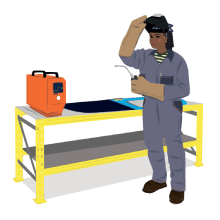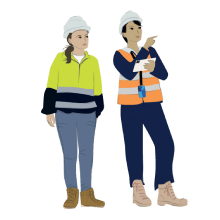Employers have a responsibility to ensure gender is not a barrier to employment, by creating workplaces that are safe and supportive for everyone to participate in.
Helping more women to join and thrive in the sector will also bring other benefits for businesses and the economy.
There are many things employers can do to support women’s participation and equity in Victoria’s manufacturing sector. This includes but is not limited to:
- Inclusive and open-minded recruitment processes – for example focus on the skills needed in position ads, rather than the specific education or years of industry experiences to broaden the talent pool.
- More flexible work options for people with caring responsibilities – such as offering flexible start and finish times and job-sharing arrangements.
- Appropriate facilities and equipment for women – for example ensuring women and gender diverse people have access to appropriate bathrooms, sanitary bins, and personal protective equipment (PPE) (including maternity and culturally appropriate PPE).
- Wraparound supports for women’s career progression – such as mentoring, leadership programs, networking opportunities, peer support, cultural leave and family violence leave.
- Re-thinking what and who makes a good leader – for example taking a holistic view of what an effective leader is through prioritising leaders who foster a collaborative, empathetic and inclusive approach.
- Additional and targeted support to overcome systemic barriers to participation and advancement – such as offering reproductive leave, providing a safe and private space for workers to pray, and ensuring workplaces are age-friendly and accessible for women with disabilities.
Resources, toolkits and templates
Employer obligations
- WorkSafe Victoria’s WorkWell Toolkit
A practical toolkit to help employers prevent and manage work-related gendered violence.
WorkSafe Victoria’s WorkWell Toolkit section - Victorian Equal Opportunity and Human Rights Commission’s Guideline: Preventing and responding to workplace sexual harassment
Six minimum standards for employers to meet their duty to eliminate sexual harassment.
VEOHRC’s Guideline: Preventing and responding to workplace sexual harassment page - Fair Work Ombudsman information on family violence leave
Family and domestic violence leave - Victorian Fair Jobs Code
Standards on fostering workplace equity and diversity. Businesses can apply for a Pre-Assessment Certificate to show they meet the code.
Buying For Victoria’s Fair Jobs Code page - Safe Respectful Workplaces training
The Victorian Trades Hall Council (VTHC) provide training for industrial officers, organisers, workers and management that is focused on eradicating gendered violence, and building safe and respectful workplaces using the rights and responsibilities conferred by the Occupational Health and Safety Act.
VTHC Safe Respectful Workplace page
Supporting gender equality in the workplace
- Pay Equality Toolkit
A set of resources for small to medium enterprises in Victoria to help them achieve equal pay.
VEOHRC’s Pay Equality Toolkit page - Workplace Gender Equality Agency’s Gender Equality Toolkit
Includes a guide to developing a gender equality strategy and a diagnostic tool to assess performance and identify gaps.
WGEA’s Gender strategy toolkit page - Our Watch’s Workplace Equality and Respect Program
Includes free tools to help businesses identify actions to promote gender equality and respect.
Our Watch’s Workplace, Equality and Respect page - South East Melbourne Manufacturers Alliance
Offers training and events for employers in South East Melbourne looking to foster inclusive and diverse workplaces.
Women in manufacturing page - Champions of Change Coalition’s online resources
Includes resources for leaders on fostering inclusive gender equality in the workplace and guidance on closing gender pay gaps.
Champions of Change Coalition’s Reports and resources page - Commission for Gender Equality in the Public Sector’s (CGEPS) leading practice resources
Practical resources to help businesses improve gender equality.
CGEPS’ Leading practice resources page - Victorian Women’s Health Services workplace training
Includes training on bystander action.
Victorian Women’s Health Services website - WORK180
Helps employers focus, track and amplify their diversity, equity and inclusion efforts, as well as connect with prospective female employees seeking inclusive workplaces
WORK180 website - National Association of Women in Operations
Offers programs for operations leaders to build inclusive leadership capabilities.
NAWO website - NAWO Case Study series
Funded by the Victorian Government, NAWO’s Case Study series spotlights the inspiring journeys towards greater diversity and inclusion for manufacturing and energy sectors employers across Victoria.
NAWO x Case Studies website - Empowered Women in Trades
Provides programs and services to increase women and non-binary people’s participation in trades.
EWIT website - Tradeswomen Australia’s training and support programs
Offers a range of training programs for employers looking to improve diversity and inclusion.
Tradeswomen Australia’s Training and support services page - Victorian Women’s Trust’s menstrual and menopause wellbeing policy template
Example of how organisations can supports their staff’s health and wellbeing with a menstrual and menopause wellbeing policy.
VWT’s Menstrual and menopause wellbeing policy page - Champions of Change
Resources for employers on how to create flexibility for shift and site-based workers.
Shifting Expectations: Flexibility for frontline, shift and site-based roles - Jobsbank
An independent, non-for-profit Victorian organisation that helps businesses create inclusive workplaces and supports inclusive social procurement.
Jobsbank website
Spotlight on Victorian Government action
Pay Equality Toolkit
The Pay Equality Toolkit is a set of resources for small-to-medium sized enterprises (SMEs) in Victoria to help them achieve equal pay.
The toolkit includes:
- information on equal pay concepts
- a progress self-assessment tool, the Pay Equality Compass
- templates and guidance for creating things like audits and action plans.
The Compass helps SMEs assess strengths and opportunities in their business practices. It also identifies which tools they should use to meet their goals around equal pay. Tools include:
- a sample equal pay policy
- a model for handling complaints
- advice on how to conduct a gender pay audit
- a capability matrix to help businesses understand the skills each role needs
- other workbooks and templates for SMEs to tailor and use.
Leading practice examples
Updated





